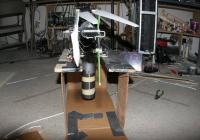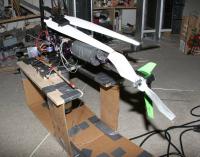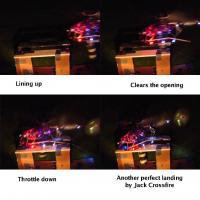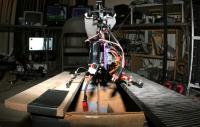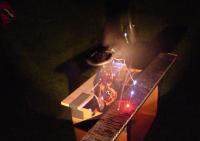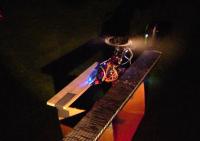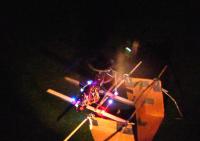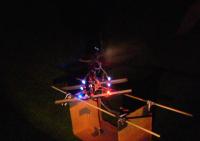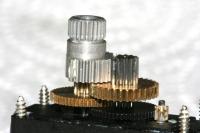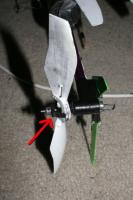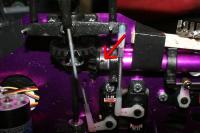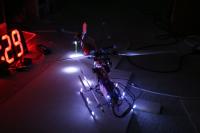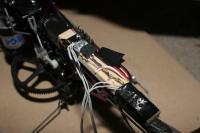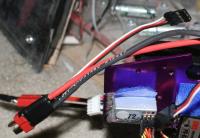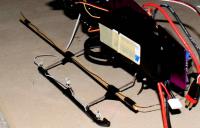Archive for November, 2006
-
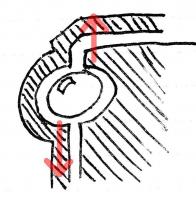 Views: 503
Views: 503
The Corona swashplate exerts sheering force on the balls to transfer deflections of the servo pushrods to the rotor head. The inner part is stationary and connects to the servos. The outer part spins and connects to the rotor head. -
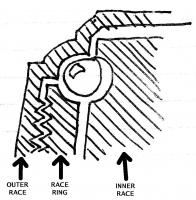 Views: 394
Views: 394
To compensate for wear, they divided the outer part into an outer race+race ring which can be expanded or contracted. -
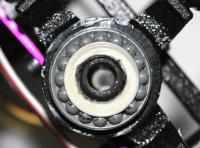 Views: 431
Views: 431
The swashplate was feeling a bit too lose and looking a bit grey from metal filings. -
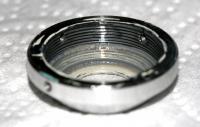 Views: 408
Views: 408
Grey grease never looked good. -
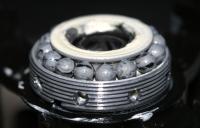 Views: 404
Views: 404
The grease mixed with a bit of oil from our attempts to lubricate the pushrods. -
 Views: 413
Views: 413
A handy dandy NdFeB magnet+paper towel pops the balls right out. -
 Views: 409
Views: 409
As grey as the Calif* sky. -
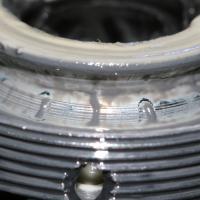 Views: 387
Views: 387
Predicted darker grease from metal filings but it was suprisingly light.
Comments (0)
Add Comment
-
 Views: 445
Views: 445
Camera's view of the successful landing. -
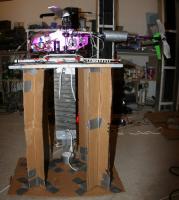 Views: 485
Views: 485
Landing platform 6 was a complete mockup of the camera pylon and 2' tall skid platform. It only had to last 6 minutes. -
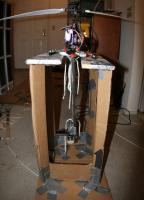 Views: 466
Views: 466
The skid platform was out of ground effect. -
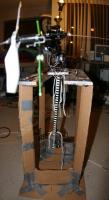 Views: 468
Views: 468
The approach to landing platform 6 had a wider opening than the exit.
-
 Views: 487
Views: 487
Takeoff crash, proving it's hopelessly obsessed with that country. -
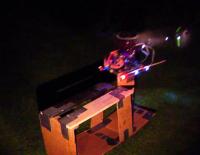 Views: 453
Views: 453
Jack Crossfire approaches another perfect landing. -
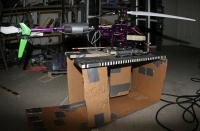 Views: 480
Views: 480
Landing platform #5 -
 Views: 469
Views: 469
Landing platform #5 -
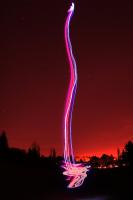 Views: 496
Views: 496
A copter can lift off vertically like a space shuttle. -
 Views: 419
Views: 419
A copter can lift off vertically like a space shuttle. -
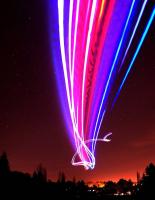 Views: 449
Views: 449
A copter can fly horizontally like a space shuttle. -
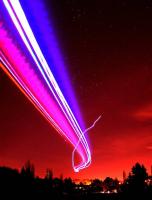 Views: 392
Views: 392
A copter can fly horizontally like a space shuttle.
-
 Views: 433
Views: 433
The Bell/Hiller is a mechanical averager. One end's height is set by the swashplate. The other end's height is set by the flybar. The output height is the average of the swashplate and flybar heights. -
 Views: 377
Views: 377
Custom swashplate input rod. Avoid beheading by not doing this and only using official parts in your 1700rpm rotor. -
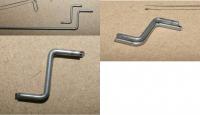 Views: 358
Views: 358
Custom Z-link output rod. Avoid beheading by not doing this and only using official parts in your 1700rpm rotor. -
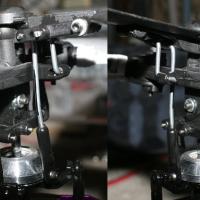 Views: 382
Views: 382
Custom Bell/Hiller rods with markings to aid tracking and of course, it flew. Avoid beheading by not doing this and only using official parts in your 1700rpm rotor. -
 Views: 455
Views: 455
This view of the stock B/H assembly also shows the Jesus bolt, supporting the entire copter's weight, so named because if it fails the next thing your copter sees will be Jesus. -
 Views: 446
Views: 446
Not sure where this one came from. Could never have planned it. Looks like a wish by some country that's never going to happen. Was a low altitude pass followed by climb but the shutter closed at just the right moment. -
 Views: 392
Views: 392
No color correction. -
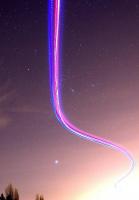 Views: 411
Views: 411
Across the stars.
-
 Views: 728
Views: 728
Meet the Pelosicopter. Had to point downwind for these shots and fight to keep her from turning around and attacking. -
 Views: 517
Views: 517
Bow to the speaker of the house, you rag. -
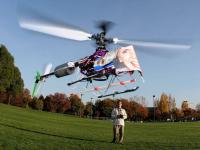 Views: 463
Views: 463
2 Amps for me and no Amps for you with Lincoln polymer. -
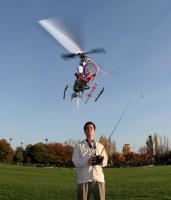 Views: 531
Views: 531
With Pelosicopter put away by the Israeali army, time for some new portraits. -
 Views: 489
Views: 489
Fly away in fear. -
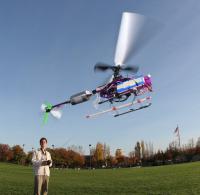 Views: 461
Views: 461
The Lithium polymer locomotive. -
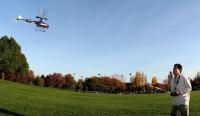 Views: 370
Views: 370
Nose-in excitement
-
 Views: 525
Views: 525
Views from the edge of space brought 2 U by the copter. Highest altitude so far. -
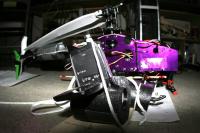 Views: 440
Views: 440
Camera mount #7 was an upside down camera on the table. The camera was too loose in this position. -
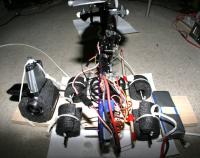 Views: 391
Views: 391
Padding on the skids was reduced to expose the LEDs and get tighter contact. -
 Views: 430
Views: 430
It's the copter poodle U might say. -
 Views: 397
Views: 397
Way too far away. -
 Views: 380
Views: 380
Sorry that it messed with the U. Know. of Where. -
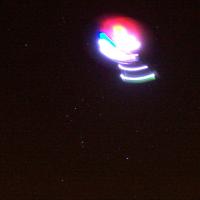 Views: 405
Views: 405
Nose-in, brought 2 U courtesy of the red, white, and blue. -
 Views: 389
Views: 389
5 second exposures, low altitude passes heading in and out in front of Orion should look best.
-
 Views: 593
Views: 593
Couldn't afford a 5D flashlight so built a 5D harness out of a 3D light and aluminum. -
 Views: 430
Views: 430
The lightbulb melts the reflector if left on in warm conditions. -
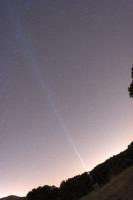 Views: 480
Views: 480
Magorator in use. -
 Views: 473
Views: 473
The lightbulb was made from a halogen and a conventional bulb. -
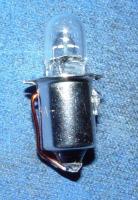 Views: 421
Views: 421
The lightbulb was made from a halogen and a conventional bulb in Nov 2005 and hasn't burned out yet. -
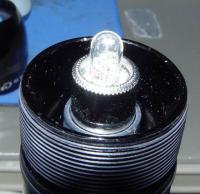 Views: 335
Views: 335
Halogen bulb in flashlight intended for conventional bulb. -
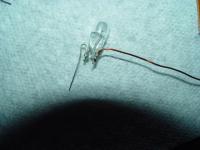 Views: 390
Views: 390
It is critical not to bend the halogen leads during fabrication or it will explode when turned on. -
 Views: 434
Views: 434
More magorator in use.
-
 Views: 542
Views: 542
The Futaba horns are not as optimally sized as the Hitec horns. Either too long or too short. -
 Views: 474
Views: 474
The Futaba with really short wire and crazy connector -
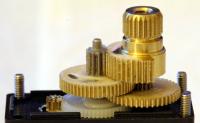 Views: 561
Views: 561
4 brass & 1 nylon in the Futaba gearbox. 180` only. Recall Hitec has a steel main gear and a much lower reduction in the final step. -
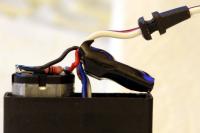 Views: 521
Views: 521
Electronics wrapped up. Decided against redoing the heat shrink tubing and splicing the cable instead. -
 Views: 567
Views: 567
Another electronics view. Well sealed motor. -
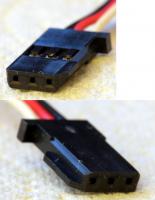 Views: 524
Views: 524
The crazy Futaba connector -
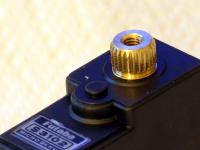 Views: 539
Views: 539
Closeup of Futaba's gnarly head. Not as precise as the Hitec but indestructable.
-
 Views: 381
Views: 381
Video from the 4 leg, 2 bladed monster. Resolution at night isn't high enough to see vibration. -
 Views: 405
Views: 405
Camera mount #6 fastened with string. -
 Views: 383
Views: 383
No padding on the skids. -
 Views: 398
Views: 398
Relied on padding the lens to reduce vibration. -
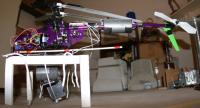 Views: 429
Views: 429
-
 Views: 505
Views: 505
Periodic noise in the camera audio showed the rotor speed. Audio analysis is impossible in high wind.
-
 Views: 444
Views: 444
On the first night camera flight, only downsampling to 320x180 could get enough dynamic range to see anything. -
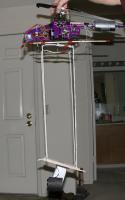 Views: 466
Views: 466
If U don't know where this is going, grow a mane. -
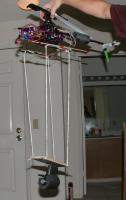 Views: 414
Views: 414
Based on the experience with the swaying halogen, tried to stabilize it with 4 strings. -
 Views: 448
Views: 448
The result of this was of course, horrific. -
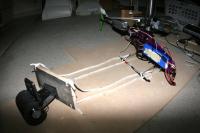 Views: 407
Views: 407
Takeoff position for the hanging camera. -
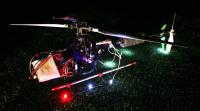 Views: 408
Views: 408
The lighted beast after flying in rain. -
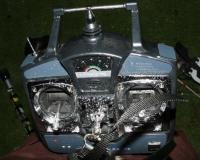 Views: 518
Views: 518
Transmitter still functional. -
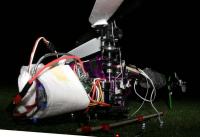 Views: 362
Views: 362
Wrapped receiver to keep it dry.
-
 Views: 495
Views: 495
Made the camera table smaller and made a fillet to overcome the cockeyed lens. -
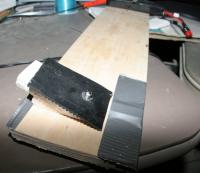 Views: 389
Views: 389
Making a balsa fillet to tilt the lens down was brutal. -
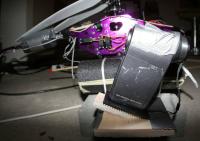 Views: 429
Views: 429
Who knows what the camera designers of Japan have in mind to torture us with in the future. There's absolutely no reason for a camera lens to be tilted.
-
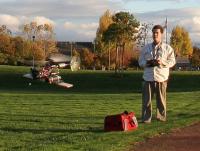 Views: 648
Views: 648
More unstable than a software manager. -
 Views: 532
Views: 532
Serious, unbelievable wind. Take a look at the flag. U know the one. -
 Views: 454
Views: 454
Didn't intend 2 get into this situation, but the flag tells the story. -
 Views: 369
Views: 369
Rock solid confidence as the copter flies away, blown uncontrollably by the wind. -
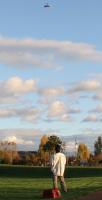 Views: 394
Views: 394
Nose-in high altitude? No problem if you practiced with the LEDs. -
 Views: 503
Views: 503
The last shot before tail rotor failure. -
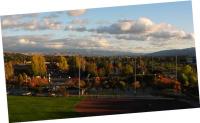 Views: 376
Views: 376
Pointing South during 20mph North wind -
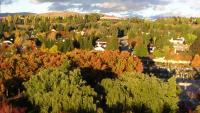 Views: 460
Views: 460
Pointing East during 20mph North wind
-
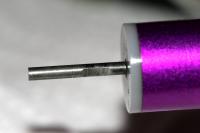 Views: 405
Views: 405
Ground a flat in the tail drive shaft. Much stiffer now, but if the tail ever jams it's going to grind up the shaft nicely. -
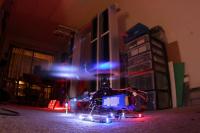 Views: 423
Views: 423
Also have some spinning rotor shots with the lighting. Contrary to the Canon's view, the blue LED seems 2 B fading. -
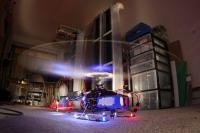 Views: 450
Views: 450
Another shot with the blade tracking emphasized. Every time this copter is moved, it shifts in or out by 1 turn so we don't bother trying to keep it within the last turn.
-
 Views: 413
Views: 413
It isn't what you think. RW & B are the only LED colors we have in the dumpy apartment. -
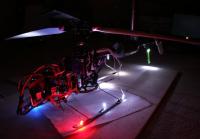 Views: 347
Views: 347
Replaced some white LEDs with red & blue to help orientation some more. -
 Views: 370
Views: 370
Unfortunately blue is almost indistinguishable from white on this copter. -
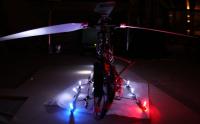 Views: 359
Views: 359
Nose in. -
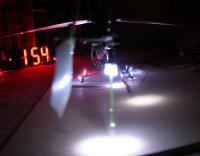 Views: 371
Views: 371
Nose out. -
 Views: 381
Views: 381
Very patriotic. -
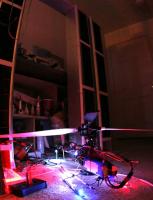 Views: 395
Views: 395
These colors sometimes run but usually crash.

